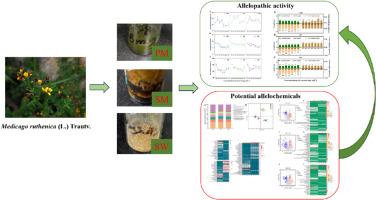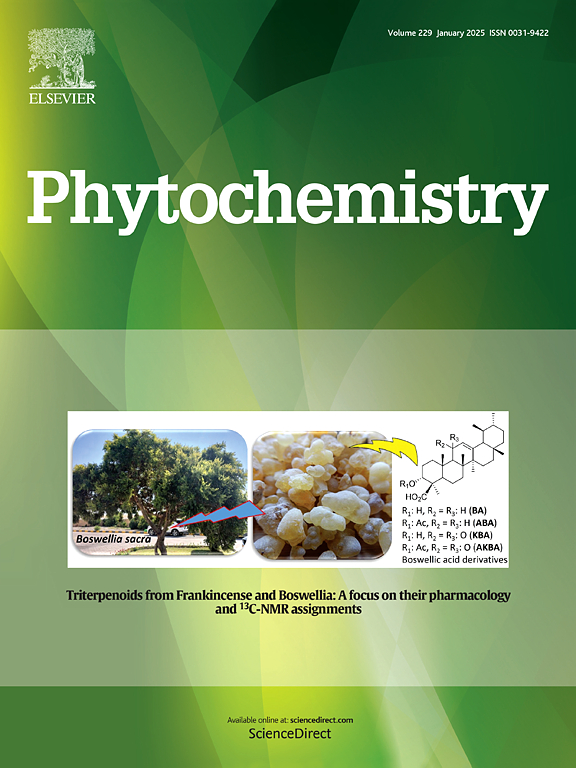苦楝草化感作用的研究Trautv。化感效应和非靶向代谢组学的见解
IF 3.4
2区 生物学
Q2 BIOCHEMISTRY & MOLECULAR BIOLOGY
引用次数: 0
摘要
禾本科、豆科等优势乡土植物的化感作用有利于退化草地生态系统植物群落的恢复和生态格局的塑造。本研究采用植物生物测定与非靶向代谢组学相结合的方法,对黑荆芥植物甲醇提取物(PM)、根际土壤水提取物(SW)和根际土壤甲醇提取物(SM)的化感活性和潜在化感物质进行了研究。结果表明,三种提取物在不同浓度下均能抑制苜蓿种子的萌发。这些提取物对黑荆芥幼苗生长的抑制作用表明其存在自毒潜能。在3种伴生草地植物幼苗中,嗜冷草对3种提取物均有正响应,而钟摆草对3种提取物均有负响应。杉木对PM和SM处理均表现为负响应,而对SW处理则表现为正响应。代谢组学数据分析显示,在三个提取物组中共有1,242种代谢物被注释。在PM组中,短链有机酸及其衍生物的相对丰度较高。SW组生物碱和类黄酮含量较高,SM组长链有机酸及其衍生物相对丰度较高。短链有机酸及其衍生物和黄酮类化合物被鉴定为与白刺草相关的潜在化感物质。本研究证实了白刺草的化感作用潜力,揭示了其物种特异性化感作用特征,为其在退化草原生态恢复中的应用提供了理论依据。本文章由计算机程序翻译,如有差异,请以英文原文为准。

Unraveling allelopathic potential of Medicago ruthenica (L.) Trautv.: insights from allelopathic effects and untargeted metabolomics
The allelopathic effects of dominant native plants such as grasses and legumes are conducive to restore plant communities and shape ecological patterns in degraded grassland ecosystems. In the present study, plant bioassays combined with untargeted metabolomics were employed to explore the allelopathic activity and potential allelochemicals of plant methanol extract (PM), rhizosphere soil water extract (SW), and rhizosphere soil methanol extract (SM) of M. ruthenica. The results indicated that three extracts inhibited the germination of L. sativa seeds at all tested concentrations. The inhibitory effects of these extracts on the seedling growth of M. ruthenica suggested the presence of autotoxicity potential. Among the three companion grassland plants seedlings, P. crymophila responded positively to three extracts, while A. pendulum exhibited negative responses. P. kansuensis showed negative responses to PM and SM treatments but responded positively to SW treatment. Metabolomic data analysis revealed that a total of 1,242 metabolites were annotated across the three extract groups. In the PM group, short-chain organic acids and their derivatives exhibited higher relative abundances. The SW group was enriched in alkaloids and flavonoids, while the SM group showed higher relative abundances of long-chain organic acids and their derivatives. The short-chain organic acids, their derivatives, and flavonoids were identified as potential allelochemicals associated with M. ruthenica. This study has confirmed the allelopathic potential of M. ruthenica and revealed its species-specific allelopathic characteristics, which provides a theoretical basis for its application in the ecological restoration of degraded grasslands.
求助全文
通过发布文献求助,成功后即可免费获取论文全文。
去求助
来源期刊

Phytochemistry
生物-植物科学
CiteScore
6.40
自引率
7.90%
发文量
443
审稿时长
39 days
期刊介绍:
Phytochemistry is a leading international journal publishing studies of plant chemistry, biochemistry, molecular biology and genetics, structure and bioactivities of phytochemicals, including ''-omics'' and bioinformatics/computational biology approaches. Phytochemistry is a primary source for papers dealing with phytochemicals, especially reports concerning their biosynthesis, regulation, and biological properties both in planta and as bioactive principles. Articles are published online as soon as possible as Articles-in-Press and in 12 volumes per year. Occasional topic-focussed special issues are published composed of papers from invited authors.
 求助内容:
求助内容: 应助结果提醒方式:
应助结果提醒方式:


